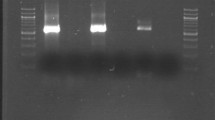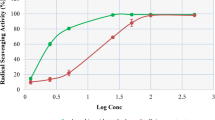Abstract
Calendula officinalis has been traditionally used in India for treating wounds, ulcers, herpes, scars, skin damage, frostbite and blood purification. Present study was aimed to evaluate antacid capacity in-vitro and antiulcer activity of extract from Calendula officinalis L. (family: Asteraceae) in experimental rats. Evaluation of ethanol extract (100 and 200 mg/kg, orally) from Calendula officinalis (ECO) as antisecretory and in-vivo antacid capacity were carried out by pyloric ligation induced ulcer model. The gastroprotective effect was carried out by absolute ethanol induced ulcer and indomethacin induced ulcer model. Integrity of gastric mucosa was evaluated by the estimation of glutathione (GSH) and gastric mucus level. The in-vitro antacid capacity was evaluated by titration method. ECO produced significant inhibition of ulcer index in all models of ulcers and comparable to standard. The in- vitro antacid capacity was found as 20.58 ± 0.08 mEq/g of ECO. The total protein and pepsin level were found as 92.45 ± 1.89 μg/ml and 34.67 ± 1.25 μmole/ml, respectively in pylorus ligation model at 200 mg/kg of ECO. GSH level were significant elevated by 200 mg/kg of ECO (P < 0.01) in indomethacin induced ulcers and shows superiority over standard drug (P < 0.05). Gastric wall mucus level was increased in all three models of ulcers and comparable to the ranitidine. We believe that the antiulcer activity of Calendula officinalis was due to its antisecretory and gastroprotective effect on experimental rats. Our results contribute towards validation of the traditional use of Calendula officinalis in the treatment ulcers.





Similar content being viewed by others
References
Anson ML (1938) The estimation of pepsin, trypsin, papain and catepsin with haemoglobin. J Gen Physiol 22:78–79
Basch E, Bent S, Foppa I, Haskmi S, Kroll D, Mele M, Szapary P, Ulbricht C, Vora M, Yong S (2006) Marigold (Calendula officinalis L.): an evidence-based systematic review by the natural standard research collaboration. J Herb Pharmacother 6:135–159
Berenguer B, Sanchez LM, Quilez A, Lopez-Barreiro M, de Haro O, Galvez J, Martin MJ (2006) Protective and antioxidant effects of Rhizophora mangle L. against NSAID-induced gastric ulcers. J Ethnopharmacol 103:194–200
Card WI, Marks IN (1960) The relationship between the acid output of the stomach following “maximal” histamine stimulation and the parietal cell mass. Clin Sci 19:147–163
Cemek M, Yilmaz E, Buyukokuroglu ME (2010) Protective effect of Matricaria chamomilla on ethanolinduced acute gastric mucosal injury in rats. Pharm Biol 48(7):757–763
Corne SJ, Morrissey SM, Woods RJ (1974) A method for the quantitative estimation of gastric barrier mucus. J Physiol 242:116–117
de Oliveira AP, Santin JR, Lemos M, Klein JLC, Couto AG, Bittencourt CMS, Filho VC, de Andrade SF (2011) Gastroprotective activity of methanol extract and marrubiin obtained from leaves of Marrubium vulgare L. (Lamiaceae). J Pharm Pharmacol 63:1230–1237
De-Andrade SF, Lemos M, Comunello E, Noldin VF, Filho VC, Niero R (2007) Evaluation of the antiulcerogenic activity of Maytenus robusta (Celastraceae) in different experimental ulcer models. J Ethnopharmacol 113(2):252–257
Devi RS, Narayan S, Vani G, Devi CSS (2007) Gastroprotective effect of Terminalia arjuna bark on diclofenac sodium induced gastric ulcer. Chem Biol Interact 167(1):71–83
Gupta M, Mazumder UK, Manikandan L, Bhattacharya S, Senthilkumar GP, Suresh R (2005) Anti-ulcer activity of ethanol extract of Terminalia pallida Brandis. in Swiss albino rats. J Ethnopharmacol 97(2):405–408
Hisam EEA, Zakaria ZA, Mohtaruddin N, Rofiee MS, Hamid HA, Othman F (2012) Antiulcer activity of the chloroform extract of Bauhinia purpurea leaf. Pharm Biol 50(12):1498–1507
Jainu M, Mohan KV, Devi CSS (2006) Gastroprotective effect of Cissus quadrangularis extract in rats with experimentally induced ulcer. Indian J Med Res 123:799–806
Jimenez-Medina E, Garcia-Lora A, Paco L, Algarra I, Collado A, Garrido F (2006) A new extract of the plant calendula officinalis produces a dual in vitro effect: cytotoxic anti-tumor activity and lymphocyte activation. BioMed Cent Cancer 6:119.1–119.14
Katalinic V, Milos M, Kulisic T, Jukic M (2006) Screening of 70 medicinal plant extracts for antioxidant capacity and total phenols. Food Chem 94:550–557
Khare CP (2004) Encyclopedia of Indian medicinal plants. Springer-Verlag Publisher, Germany
Kirtikar KR, Basu BD (2005) Indian medicinal plants, 2nd edn. International Book Distributors, Dehradun
Klein-Juniora LC, Santin JR, Lemos M, Silveira ACO, Rocha JAR, Beber AP, Wagnerb TM, Bresolina TMB, Cruza AB, Filhoa VC, de Andradea SF (2013) Role of gastric mucus secretion, oxinitrergic system and sulfhydryl groups on the gastroprotection elicited by Polygala cyparissias (Polygalaceae) in mice. J Pharm Pharmacol 65:767–776
Kukarni SK (1999) Handbook of experimental pharmacology, 3rd edn. Vallabh Prakashan, Delhi
Lapa FR, Freitas CS, Baggio CH, Missau FC, Pizzolatti MG, Santos ARS, Marques MCA (2007) Gastroprotective activity of the hydroalcoholic extract obtained from Polygala paniculata L. in rats. J Pharm Pharmacol 59:1413–1419
Lowry CH, Randall RJ (1951) Protein measurement with Folin phenol reagent. J Biol Chem 193:265–275
Megala J, Geetha A (2012) Antiulcerogenic activity of hydroalcoholic fruit extract of Pithecellobium dulce in different experimental ulcer models in rats. J Ethnopharmacol 142:415–421
Morimoto Y, Shimohara K, Oshima S, Sukamoto T (1991) Effects of the new anti-ulcer agent KB-5492 on experimental gastric mucosal lesions and gastric mucosal defensive factors, as compared to those of terprenone and cimetidine. Jpn J Pharmacol 57(4):495–505
Muley BP, Khadabadi SS, Banarase NB (2009) Phytochemical constituents and Pharmacological activities of Calendula officinalis Linn (Asteraceae): a review. Trop J Pharm Res 8(5):455–465
OECD (2001) Acute oral toxicity. Acute oral toxic class method guideline 423 adopted 17.12.2001. In: Eleventh Addendum to the, OECD, guidelines for the testing of chemicals, organization for economic co-operation and development. Paris
Okoli CO, Ezike AC, Akah PA, Udegbunam SO, Okoye TC, Mbanu TP, Ugwu E (2009) Studies on wound healing and antiulcer activities of extract of aerial parts of Phyllanthus niruri L. (Euphorbiaceae). Am J Pharmacol Toxicol 4:118–126
Parente LM, Andrade MA, Brito LA, Moura VM, Miguel MP, Lino-Junior Rde S, Tresvenzol LF, Paula JR, Paulo NM (2011) Angiogenic activity of Calendula officinalis flowers L. in rats. Acta Cir Bras 26:19–24
Penisi A, Piezzi R (1999) Effect of dehydroelucidine on mucus production: a quantitative study. Dig Dis Sci 44:708–712
Pommier P, Gomez F, Sunyach MP, D’Hombres A, Carrie C, Montbarbon X (2004) Phase III randomized trial of Calendula officinalis compared with trolamine for the prevention of acute dermatitis during irradiation for breast cancer. J Clin Oncol 22:1447–1453
Re TA, Mooney D, Antignac E, Dufour E, Bark I, Srinivasan V, Nohynek G (2009) Application of the threshold of toxicological concern approach for the safety evaluation of calendula flower (Calendula officinalis) petals and extracts used in cosmetic and personal care products. Food Chem Toxicol 47:1246–1254
Sathish R, Sahu A, Natarajan K (2011) Antiulcer and antioxidant activity of ethanolic extract of Passiflora foetida L. Indian J Pharm 43:336–339
Sedlak J, Lindsay RH (1968) Estimation of total, proteinbound, and nonprotein sulfhydryl groups in tissue with Ellman’s reagent. Anal Biochem 25:192–205
Shay H, Komarov SA, Fels SS, Meranze D, Gruenstein M, Siplet H (1945) A simple method for the uniform production of gastric ulceration in the rat. Gastroenterolgy 5:43–61
Trease GE, Evans WC (1987) A text book of pharmacognosy. ELSB Baillere Tindal, Oxford
Tulassay Z, Herszenyi L (2010) Gastric mucosal defense and cytoprotection. Best Pract Res Clin Gastroenterol 24:99–108
United States Pharmacopeia (USP) XXX-National Formulary XV (2007) US Pharmacopoeial Convention, Rockville, Md
Zitterl-Eglseer K, Sosa S, Jurenitsch J, Schubert-Zssilavecz M, Della Loggia R, Tubaro A, Bertoldi M, Franz C (1997) Anti-oedematous activities of the main triterpenodiol esters of marigold (Calendula officinalis L, Asteraceae). J Ethnopharmacol 57:139–144
Acknowledgments
The authors wish to thank Prof (Dr.) R M. Dubey, Vice Chancellor, IFTM University for his generous support for the study. This study is a part of PhD from UPTU, Lucknow.
Ethical Statement
This study was approved by the Institutional animal ethics committee (IAEC) and performed in accordance with the ethical standard laid down in the 1964 Declaration of Helsinki and its later amendments.
Conflict of Interest
None
Author information
Authors and Affiliations
Corresponding author
Rights and permissions
About this article
Cite this article
Chandra, P., Kishore, K. & Ghosh, A.K. Evaluation of antacid capacity and antiulcer activity of Calendula officinalis L. in experimental rats. Orient Pharm Exp Med 15, 277–285 (2015). https://doi.org/10.1007/s13596-015-0195-5
Received:
Accepted:
Published:
Issue Date:
DOI: https://doi.org/10.1007/s13596-015-0195-5




